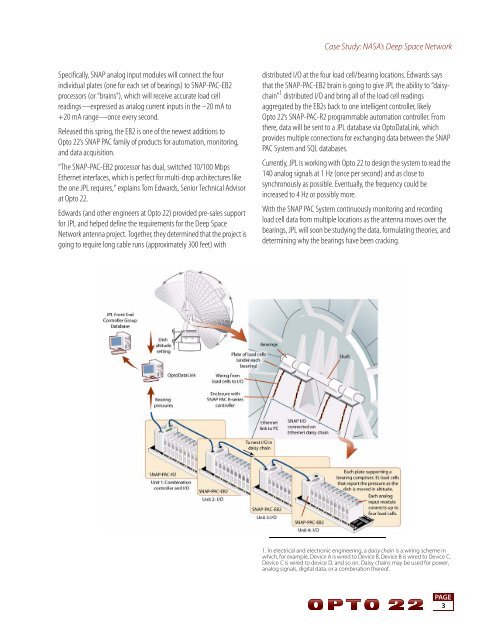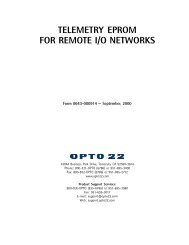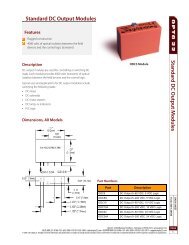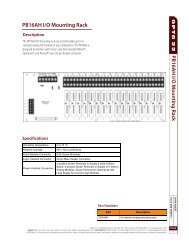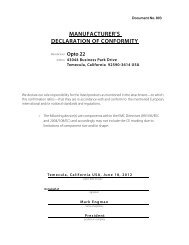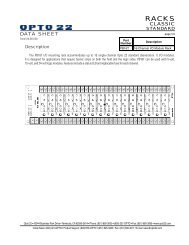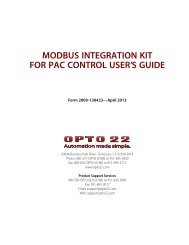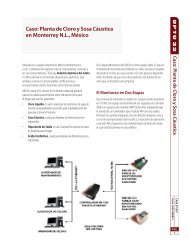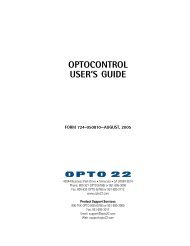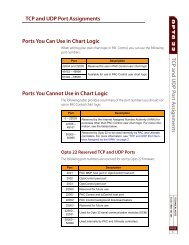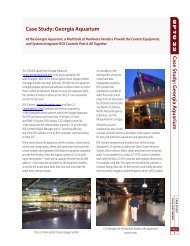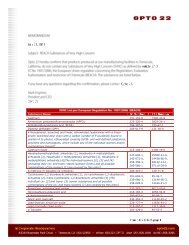Case Study: NASA's Deep Space Network C ase Study ... - Opto 22
Case Study: NASA's Deep Space Network C ase Study ... - Opto 22
Case Study: NASA's Deep Space Network C ase Study ... - Opto 22
You also want an ePaper? Increase the reach of your titles
YUMPU automatically turns print PDFs into web optimized ePapers that Google loves.
<strong>C<strong>ase</strong></strong> <strong>Study</strong>: NASA’s <strong>Deep</strong> <strong>Space</strong> <strong>Network</strong><br />
Specifically, SNAP analog input modules will connect the four<br />
individual plates (one for each set of bearings) to SNAP-PAC-EB2<br />
processors (or “brains”), which will receive accurate load cell<br />
readings—expressed as analog current inputs in the –20 mA to<br />
+20 mA range—once every second.<br />
Rele<strong>ase</strong>d this spring, the EB2 is one of the newest additions to<br />
<strong>Opto</strong> <strong>22</strong>’s SNAP PAC family of products for automation, monitoring,<br />
and data acquisition.<br />
“The SNAP-PAC-EB2 processor has dual, switched 10/100 Mbps<br />
Ethernet interfaces, which is perfect for multi-drop architectures like<br />
the one JPL requires,” explains Tom Edwards, Senior Technical Advisor<br />
at <strong>Opto</strong> <strong>22</strong>.<br />
Edwards (and other engineers at <strong>Opto</strong> <strong>22</strong>) provided pre-sales support<br />
for JPL and helped define the requirements for the <strong>Deep</strong> <strong>Space</strong><br />
<strong>Network</strong> antenna project. Together, they determined that the project is<br />
going to require long cable runs (approximately 300 feet) with<br />
distributed I/O at the four load cell/bearing locations. Edwards says<br />
that the SNAP-PAC-EB2 brain is going to give JPL the ability to “daisychain”<br />
1 distributed I/O and bring all of the load cell readings<br />
aggregated by the EB2s back to one intelligent controller, likely<br />
<strong>Opto</strong> <strong>22</strong>’s SNAP-PAC-R2 programmable automation controller. From<br />
there, data will be sent to a JPL datab<strong>ase</strong> via <strong>Opto</strong>DataLink, which<br />
provides multiple connections for exchanging data between the SNAP<br />
PAC System and SQL datab<strong>ase</strong>s.<br />
Currently, JPL is working with <strong>Opto</strong> <strong>22</strong> to design the system to read the<br />
140 analog signals at 1 Hz (once per second) and as close to<br />
synchronously as possible. Eventually, the frequency could be<br />
incre<strong>ase</strong>d to 4 Hz or possibly more.<br />
With the SNAP PAC System continuously monitoring and recording<br />
load cell data from multiple locations as the antenna moves over the<br />
bearings, JPL will soon be studying the data, formulating theories, and<br />
determining why the bearings have been cracking.<br />
1. In electrical and electronic engineering, a daisy chain is a wiring scheme in<br />
which, for example, Device A is wired to Device B, Device B is wired to Device C,<br />
Device C is wired to device D, and so on. Daisy chains may be used for power,<br />
analog signals, digital data, or a combination thereof.<br />
PAGE<br />
3


